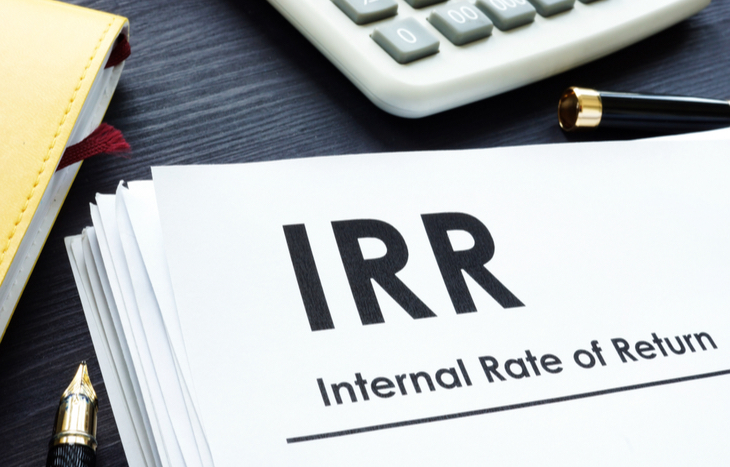Internal Rate of Return (IRR) vs. Return on Investment (ROI)
Looking forward when you are investing can be tricky. The future is never certain, and you might not always know every variable affecting your investments. Still, there’s a lot to gain by extrapolating figures out into the future. That said, it can be confusing as to which formula or metric is most insightful. Case in point: when should you use Internal Rate of Return (IRR) vs. Return on Investment (ROI)?
Seasoned investors will immediately recognize these two values as important forward-looking measures. For new investors, however, it’s easy to get confused about them—what they represent, how they’re calculated and what they’re for. Below, we’ll break down the differences of these two important metrics. Here’s a look at both, and when you should use one vs. the other in your forward-looking calculations.

What is an Internal Rate of Return (IRR)?
In layman’s terms, IRR is the rate at which an investment breaks even and becomes lucrative. If you invest $3,000 today and expect it to generate $500 annually for the next five years, you need to know how quickly you’re going to recoup your investment. IRR helps determine whether an investment is worthwhile by showing how quickly it returns value.
Time as a factor is important for investors, because we only have so much of it. You want to get the quickest results from your investments, even if you have many years to invest. Especially in instances of compounding interest, the faster you see returns, the more lucrative your eventual investment will be. The higher the IRR, the quicker you can expect to see returns.
IRR Example
- Eugene is trying to decide between investing in a rental property and putting a lump sum into a mutual fund. He calculates the IRR of both over a 15-year period. The IRR of the investment property is 8.350%; the IRR of the mutual fund is 6.850%. Eugene decides to invest in the rental property.
- Maddie invests $1,000 in a fund that returns 6%, 8%, 10%, 6% and 12% over a five-year period. Her IRR is 8.24% over the life of the investment. If the market average for returns is 8% during that time period, her investment was a good one.
What is Return on Investment (ROI)?
ROI is the total gains of an investment over the investment term. If you invest $3,000 today and your investment matures into $9,000 over three years, your ROI is $6,000—or 200%. It’s a pure look at what you’re getting for your money from an investment standpoint.
It’s important to understand that ROI calculations can become quite complex when you begin to factor in different variables. Dividends, expenses, fees, taxes and more can all affect ROI. It’s why there are different measures of ROI for investments depending on the focus of the forward-looking intent.
ROI Example
- Maribel invests $10,000 in her 401(k) and sets her contribution at $1,000/mo. She gets 7% annually over the span of 25 years. Adjusting for inflation and taxes, her investment will be $717,025. The breakdown is $310,000 invested, $238,644 in simple interest accumulated and $168,381 in compound interest.
- Luis invested $50,000 in a fund and let it sit for 20 years. The balance is now $175,000. Luis gained $125,000 on his investment for a total ROI of 250%! This breaks down to a simple annual ROI of 12.49% and a complex annual ROI of 6.46%.
Which Formula is Best Used When?
There’s a time to use IRR and a time to use ROI. It all depends on what information you’re trying to get from an investment.
IRR is important for factoring time into an investment. For example, if an Investment A takes 10 years to generate $10,000 and Investment B takes five years to generate that same return, they have an equal ROI. In this situation, the IRR of Investment B is better, because it culminates in half the time.
ROI is the primary calculation when determining the total outcome of an investment, sans time. Say you invest $10,000 in two funds and let them sit for 20 years. If Fund A is worth $100,000 and Fund B is worth $65,000, Fund A clearly has a higher ROI. In this situation, time isn’t the focus: total return is.
To see ROI at work for your own finances, check out our investment calculator. You’ll be able to plug-and-play with different variables specific to your own finances and investments. It’s worth looking at if you have questions about how your money will grow over time.
Measure the Success of Your Investments
The purpose of investments is to return value over time. While you might make an investment today, the true power of that investment manifests over years and decades. That said, it’s important to look ahead and set your expectations for the future. Calculating Internal Rate of Return (IRR) vs. Return on Investment (ROI) can help you do exactly that. You’ll have confidence putting your dollars into an investment vehicle when you can predict the expected return and make better decisions when choosing between investments.
Now, all you need is to research companies and begin investing! Sign up for the Trade of the Day e-letter below for daily stock picks and investing tips. The team at Trade of the Day does the research for you!
Keep in mind that IRR and ROI aren’t foolproof metrics, and they’re not the only forward-looking formulas to use. They’re merely tools in a toolbox of investment fundamentals every person should apply before they make decisions that could affect the future of their wealth generation. The next time you’re questioning an investment, plug values into IRR and ROI to figure out if it’s worth further consideration.





